Ivry-sur-le-Lac - Crossing an obstacle course to buy a litre of milk, or why wildlife crossings?
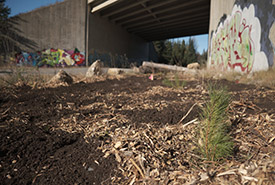
Wildlife crossing, Ivry-sur-le-Lac, QC (Photo by NCC)
Humans move around as part of daily life. It's perfectly normal to go to the grocery store, or head to the next town over to meet up with friends. But what do we do if, all of a sudden, a hostile environment springs up between our home and destination? Do we try to find another source of food for our pantry? Do we brave the challenges to get where we want to go and risk getting hurt?
It may sound absurd when put that way, but that's what animals experience. When a road, a city or a house is built in their habitat, they sometimes find themselves stuck — isolated in an environment that doesn’t have all the resources they need to survive. This is called habitat fragmentation.
A passage from burrow to raspberry bush
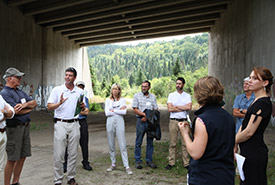
Visiting the tunnel at Ivry-sur-le-Lac, QC (Photo by NCC)
Fortunately, humans are becoming increasingly aware of this problem and actions are being taken to lessen the impact we have. In 2019, the Nature Conservancy of Canada (NCC) acquired land in Ivry-sur-le-Lac, 20 kilometres southeast of Mont-Tremblant National Park. This property already had a wildlife crossing — a place for animals to safely cross a human construction. This crossing, a tunnel that runs under Highway 117, is of great importance to the animals of the region since it is part of a forest corridor linking, among others, the natural areas of Mont-Tremblant and the Jackrabbit ecological reserve (Montcalm).
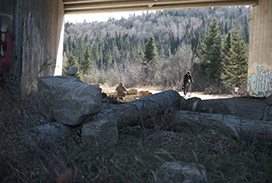
Wildlife crossing, Ivry-sur-le-Lac, QC (Photo by NCC)
But the tunnel was not very hospitable: a long corridor with no hiding place and unknown perils at the exit! As a result, few animals dared to venture through it. Fortunately, NCC has significantly redesigned the tunnel, adding rocks and vegetation along its length, and by the summer of 2022, the passage will be much more suitable for animals’ use.
Not just for animals
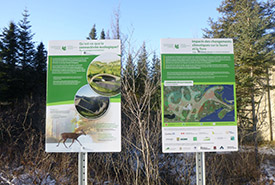
Interpretive panels set up at the tunnel (Photo by NCC)
But NCC didn't stop there. As the P'tit Train-du-Nord multi-use recreational trail also passes through the tunnel, four interpretation panels were installed at the tunnel’s openings for people passing by who might want to learn more about the tunnel’s new design. After all, the trail is popular with cyclists and hikers, who are likely to be curious as to the reasons behind the tunnel’s new design.
Is the crossing a little out of your way? Click here to enlarge the panel images and learn more about wildlife crossings, the impacts of climate change on wildlife and vehicle–animal collisions.
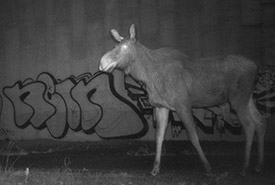
Moose, Ivry Wildlife Crossing, QC (Photo taken by surveillance cameras)
While the idea of wildlife crossings is gaining momentum, they are still quite rare in some areas. Consider this the next time you see a turtle in the middle of the road: it just mustered up the courage to cross untold danger… to fetch some good worms from the pantry on the other side!
Thank you to all of our partners and donors.
Woodcock Foundation, Quebec Ecological corridors Initiative, American Friends of Canadian Nature, the Sentier Transcanadien, the Municipalité d’Ivry-sur-le-Lac; the MRC des Laurentides; Conservation Manitou; Éco-corridors Laurentiens, the corporation du parc linéaire du P'tit Train du Nord, Concordia University.











